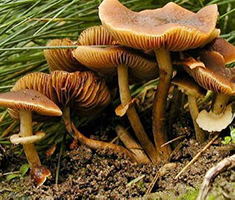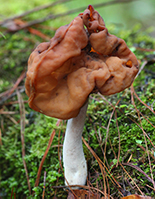While the vast majority of mushrooms are edible and even beneficial to human health, a small minority can be deadly. This poses a big issue, as mushroom hunting is fun, however, the risks of consuming can be fatal. This website written by a licensed pharmacist is dedicated to highlighting the most common errors that occur. Overall, there are 70-80 species of poisonous mushrooms, which cause around 7428 death/per year in the US; in this article, we will look at the top 10 most commonly misidentified ones so you can steer clear. To start, heed the warning of this ominous quote: "Only a few mushrooms will kill you; most will just make you wish you were dead." This relates to the fact that poisoning from mushrooms doesn't kill the ingester immediately, sometimes it can be a gruesome, slow painful death... |
 |
Number 1. The Death Cap
 |
| | | Amanita phalloides, commonly known as The Death Cap mushroom, are responsible for 90% of the world's mushroom-related fatalities¹. This olive green capped mushroom can be easily mistaken for edible mushrooms such as the puffball and the paddy straw mushroom. In our free Mushroom Identification course, we teach you how to differentiate between these species to ensure that you can pick safely. |

Number 2. Destroying Angel

| | | | "Destroying angel" (Amanita bisporigera/virosa) applies to several similar, closely related species of deadly all-white mushrooms, the closely related death caps (see above). Destroying angels are characterized by having white stalks and gills. The cap can be pure white, or white at the edge and yellowish, pinkish, or tan at the center.
|
|---|
Number 3. False Morel
Number 4. Autumn Skullcap

| | | | Galerina marginata found worldwide, is commonly known as the more friendly "Funeral Bell" or the "Deadly Skullcap". The fruit bodies of this fungus have brown to yellow-brown caps that fade in color when drying and are often mistaken for psilocybin-containing species. |
|---|
Number 5. Deadly Webcap

| | | | Mainly found in coniferous woodland in Northern Europe this mushroom is often mistaken for Cantharelus cibarius, a highly prized edible Chanterelle mushroom when eaten, it can result in kidney failure, which is often irreversible. |
|---|
Number 6. Conocybe Filaris

| | | | Often called dunce caps or cone heads, conocybes are mainly found living on grassland, lawns, rich soil and compost in North America, Europe and Asia and are especially common in the Pacific Northwest.
|
|---|
Number 7. Poison fire coral

| | | | Also known as Podostroma Cornu-damae it is mainly found in Asia where they have been responsible for several fatalities in Japan and Korea. Often referred to as "The world's second-deadliest fungus" it has recently been found in suburban Cairns, in the State of Queensland in Australia².
|
|---|
Number 8. Deadly Dapperling

| | | | Widely distributed in Europe and temperate regions of Asia as far east as China, it grows in grassy areas such as fields, parks and gardens, and is often mistaken for edible mushrooms.
|
|---|
Number 9. Angel Wing

| | | | Looks similar to the common oyster mushroom however differs in that it contains a powerful neurotoxin and the flesh is thin and fragile in comparison. Historically the mushroom has been generally regarded as edible however some recent poisonings are now showing the dark side of the mushroom. |
|---|
Number 10. Fly Agaric

| | | | Fly agaric has many names amanita muscaria, fly amanita the red and white mushroom is arguably the most iconic toadstool species. While not as deadly as other mushrooms on this list, the Fly Agaric is toxic and can cause hallucinations, nausea, and in rare cases, death. |
|---|
How can you avoid these deadly species?
Species such as the poison pie, destroying angel, the devil's bolete and the sickener get their names for a good reason. What makes things particularly tricky for identifiers is that many edible varieties are look-a-likes to toxic mushrooms that only an expert can tell the difference.
Our subscriber, online mushroom courses are dedicated to helping you gain the knowledge to easily identify non-edible, poisonous species. Below are some tips from one of our courses to help you avoid the worst of a bad bunch:
- Unfamiliar species. Check and re-check your identification, especially looking out for a similar poisonous species. If still in doubt, ask an expert or throw it away.
- Examine each specimen. Always check each specimen in case a different species has got in amongst your collection of edible ones.
- Keep your collections separate. Do not mix edible and non-edible species in a collecting tray if you are collecting for the pot. It is a good idea if collecting for the pot to only collect edible species and not other species for identification purposes.
- Check the spore print. Sometimes not possible yet a simple operation, leaving a cap on some paper and covering for an hour or so. This will help check your identification.
- Do not eat raw wild fungi. Some wild fungi are poisonous if eaten raw, e.g. Wood Blewit, Lepista nuda, the Blusher, Amanita rubescens or species of Helvella. Always cook your collections.
- Retain an uncooked specimen. This is a very sensible idea. Keep one example of what you have eaten in the fridge. In case, you do poison yourself, this will help others identify what you have eaten and therefore know how to treat you. Different species contain different toxins, therefore treatments will vary.
- Only eat good specimens. Many poisoning cases occur when edible species are eaten in poor condition, look out for rot or old mushrooms and only eat, what you think are good specimens!
- Keep your collections in the fridge. This protects your mushrooms from mould and keeps your specimens in good condition.
- Experimenting. If experimenting and eating a type for the first time, only eat a small amount. Different people react to fungi in different ways and it is safer to test your own body out gently!
- Alcohol. Avoid drinking alcohol with species you haven't eaten before and with certain species, e.g. the Common Ink Cap, Coprinus atramentarius.
- Fear. Do not feed wild mushrooms to people who don't want to eat them. Fear can make people sick.
- Susceptible people. Do not serve wild fungi to young children, old or sick people. Their resistance may be lower.
- Greed. Do not large quantities of wild mushrooms in one sitting. This alone can make you sick.
References
¹ Issue: BCMJ, vol. 61 , No. 1 , Published on: January February 2019 , Pages 20-24 Clinical Articles By: Maxwell Moor-Smith, BSc Raymond Li, BSc(Pharm), MSc Omar Ahmad, MD, FRCPC Accessed on 26 May 2020 via: https://www.bcmj.org/articles/worlds-most-poisonous-mushroom-amanita-phalloides-growing-bc
² ABC news article dated: 3 October 2019 accessed on 26 May 202 via https://www.abc.net.au/news/2019-10-03/deadly-fungi-poison-fire-coral-found-in-far-north-qld/11571162












